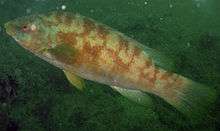Ballan wrasse
The ballan wrasse (Labris bergylta) is a species of marine ray finned fish from the family Labridae, the wrasses. It is found in the eastern Atlantic Ocean where it inhabits rock areas. Like many wrasse species it is a protogynous hermaphrodite, starting life as females with some dominant fish becoming males. It is used as a food fish in some areas and it is also finding use as a cleaner fish in the aquaculture of Atlantic salmon (Salmo salar) in north western Europe.
| Ballan wrasse | |
|---|---|
 | |
| Scientific classification | |
| Kingdom: | Animalia |
| Phylum: | Chordata |
| Class: | Actinopterygii |
| Order: | Labriformes |
| Family: | Labridae |
| Genus: | Labrus |
| Species: | L. bergylta |
| Binomial name | |
| Labrus bergylta Ascanius, 1767 | |
| Synonyms[2] | |
| |
Description
The ballan wrasse is a large, heavy bodied wrasse with a relatively deep body and quite a large head. It has a smallish mouth which is surrounded by thick, fleshy, rather wrinkled lips and the jaws are armed with a single row of robust teeth which are sharp and pointed in young fish but blunter and more worn in older fish. It has a long dorsal fin which has 18-21 spines in its anterior portion and 9-13 branched rays in the rear part. The anal fin is markedly shorter and has three spines. It has large scales with 41-47 of them in the lateral line. The juvenile fish are coloured to match their habitat and vary in clour from light green to dark green,[3] some being described a bright emerald green.[4] The adults are more variable in colour, they can either be dark green or reddish brown but are marked all over with numerous white spots.[3] It can grow to 65.9 cm (25.9 in) in total length (though most do not exceed 50 cm (20 in) standard length), and the greatest recorded weight of this species is 4.4 kg (9.7 lb). All Ballan wrasses are female for their first four to 14 years before a few change into males. Large Ballan wrasses are almost certainly male.[2]
Distribution
Ballan wrasse are native to the northeastern Atlantic Ocean from Norway to Morocco, including the islands of Madeira, the Azores and the Canary Islands. There are records from the Mediterranean Sea but these are regarded as questionable[1] and may be misidentifications of the brown wrasse (Labrus merula).[2]
Habitat and biology
They can be found at depths from 1 to 50 m (3.3 to 164.0 ft) amongst rocks, seaweed and reefs. The ballan wrasse is a prototgynous hermaphrodite and all are female for their first four to 14 years before a few change into males. Large Ballan wrasses are almost certainly male.[2] The thick lips and sharp front teeth of the ballan wrasse are an adaptation for extracting shellfish from the facies of rocks. These are supplemented by powerful, pharyngeal teeth whach are placed further back in the throat and which can break up shells to access flesh inside. This species also feeds on crustaceans and their diet includes hard-shelled crabs and small lobsters. They will swim into shallower water so that they can prey on the shellfish which cling to underwater cliff faces and inshore rocks. They will also inhabit areas with good covering of kelp and other seaweeds.[5]The male builds a nest of algae in a crevice in the rocks in which one or more females lays eggs. The male defends the nest until the eggs hatch into pelagic larvae after a week or two.[1].
Human usage
This species is popular as a food fish in the Orkney Islands and in Galway,[6] although it is not highly regarded as a food fish in much of the UK and Ireland.[5]
In recent years, it has become a popular catch-and-release target for sport fishermen using light fishing tackle, particularly those employing soft plastic lures.[7][5]
It can also be used to clean sea lice from Norwegian farmed salmon;[8] the technique is also being developed in Scotland.[9][10]
References
- Pollard, D. (2010). "Labrus bergylta". IUCN Red List of Threatened Species. 2010: e.T187398A8525211. doi:10.2305/IUCN.UK.2010-4.RLTS.T187398A8525211.en. Retrieved 14 January 2020.
- Froese, Rainer and Pauly, Daniel, eds. (2006). "Labrus bergylta" in FishBase. AugustAyear=2019 2006 version.
- Alwyne Wheeler (1992). The Pocket Guide to Salt Water Fishes of Britain and Europe (1997 ed.). Parkgate Books. p. 117. ISBN 978-1855853645.
- Ager, O.E.D. (2008). Tyler-Walters H.; Hiscock K. (eds.). "Labrus bergylta Ballan wrasse". Marine Life Information Network: Biology and Sensitivity Key Information Reviews, [on-line]. Plymouth. Marine Biological Association of the United Kingdom. Retrieved 14 January 2020.
- "Wrasse". BritishSeaFishing.co.uk. 23 November 2013. Retrieved 14 January 2020.
- Alan Davidson, North Atlantic Seafood, 1979, ISBN 0-670-51524-8
- David Erwin, Bernard Picton, "Guide to Inshore Marine Life" The Marine Conservation Society 1987 ISBN 0-907151-34-5
- https://www.sciencedaily.com/releases/2010/04/100423215021.htm
- https://www.bbc.co.uk/news/uk-scotland-scotland-business-19878554
- https://www.bbc.co.uk/news/uk-scotland-scotland-business-25005438
External links
- Photos of Ballan wrasse on Sealife Collection
